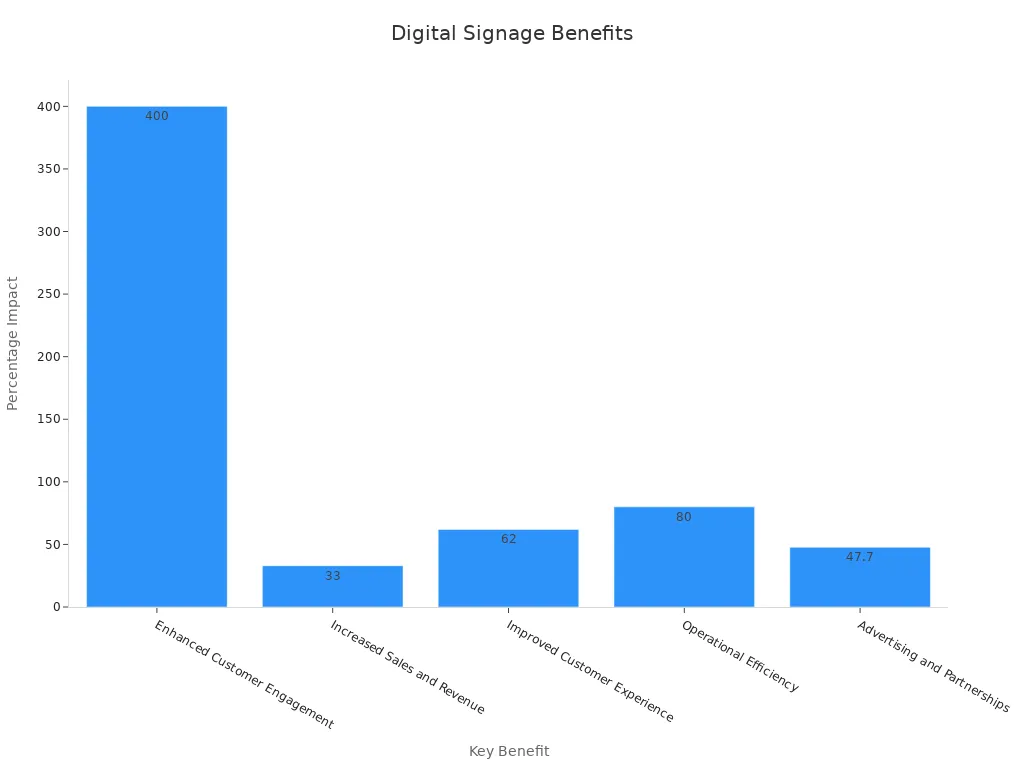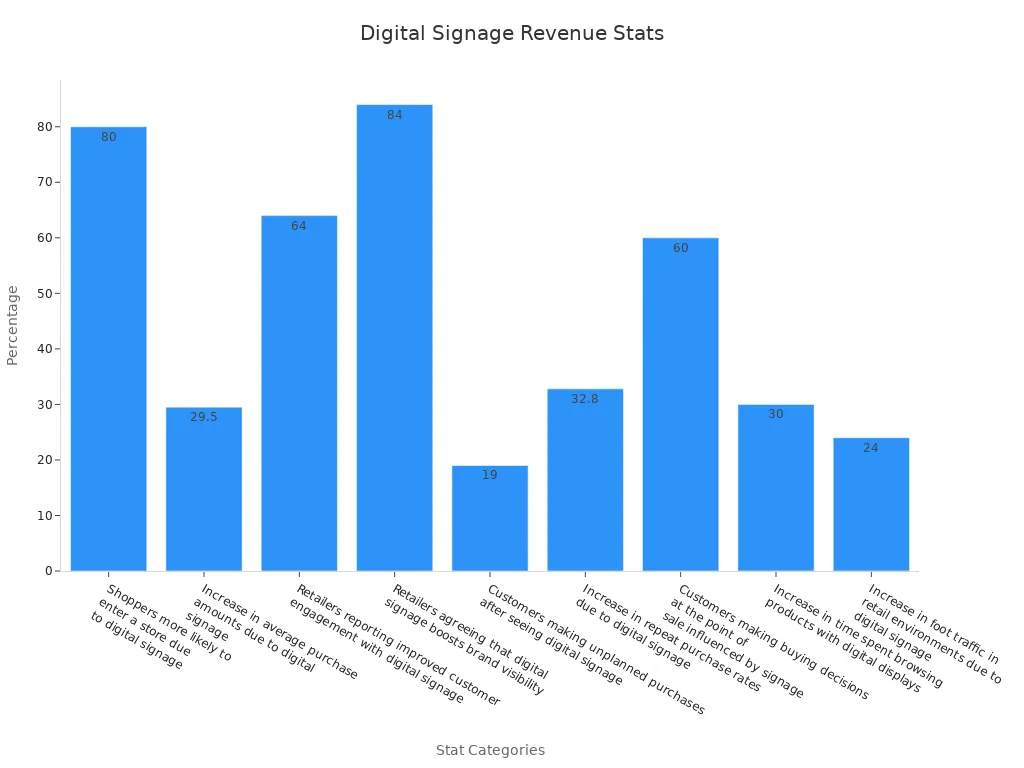Digital Signage Implementation for Maximum ROI

Digital signage is a powerful tool for businesses to attract customers and increase revenue. Its bright screens capture the attention of 63% of passersby. Approximately 7 out of 10 Americans report that signage influences their purchasing decisions. Stores utilizing digital signage have experienced a 24% increase in visitors and a 29.5% rise in spending. Around 80% of companies indicate that their sales have grown by up to 33%. This demonstrates that digital signage can significantly enhance business earnings.
The big question is: How can you effectively use digital signage to achieve the best results for your business?
Key Takeaways
Digital signs help businesses get more customers and sell more. Some companies see sales grow by 33% with good digital signs.
It's important to set clear goals to check how well signs work. Use SMART goals to plan your strategy.
Content matters a lot. Make fun and useful content that fits what your audience likes and when your promotions happen.
Pick the best technology and spots for your signs. Good screens and smart locations make them easier to see and more effective.
Check how your signs are doing often. Change the content or location based on data to get better results.
Understanding ROI in Digital Signage
What is ROI in Digital Signage?
ROI means the money you earn compared to what you spend. For digital signage, ROI shows how well your investment helps your business grow. Unlike buying equipment, marketing costs like digital signage need different ways to measure success. These include return-on-objective or return-on-marketing investment (ROMI), which check how your campaigns perform.
To figure out ROI in digital signage, look at these things:
Audience engagement: See how long people watch and interact.
Sales and revenue: Check if sales and conversions go up.
Operational efficiency: Look at cost savings and staff productivity.
Brand awareness: Measure how well people remember your brand.
Customer satisfaction: Use surveys to find out if customers are happy.
By studying these areas, you can see how digital signage helps your business.
Why ROI Matters for Digital Signage
ROI is key to making sure your digital signage works well. Without tracking ROI, you might spend too much on tools or content that don’t help. Businesses that focus on ROI can improve their plans to get better results.
For example, research shows good digital signage can raise sales by 33% and boost customer engagement by 47%. This proves why setting clear goals for your signage is important. It helps you improve messages, arrange products better, and fix problems.
When you focus on ROI, every dollar spent helps your business grow. This not only increases profits but also builds a stronger connection with your audience.
Step-by-Step Guide to Digital Signage Implementation

Setting Clear Objectives and KPIs
To use digital signage well, start with clear goals. These goals act like a map, helping you stay on track. For example, you might want more visitors, higher sales, or happier customers. Setting these goals gives you a strong starting point.
After setting goals, pick Key Performance Indicators (KPIs) to measure success. KPIs show how well your digital signage is working. Numbers like Customer Satisfaction Score (CSS), audience engagement, and ROI are helpful. CSS shows if customers like your signs, while ROI shows how much money you make.
Tip: Use SMART goals—Specific, Measurable, Attainable, Relevant, and Time-bound—to make your goals easy to follow.
Crafting a Comprehensive Strategy
A good plan is key for digital signage success. First, check what tools you already have and what’s missing. Then, make a plan with clear steps, a budget, and a timeline.
Your plan should also focus on your audience. Knowing your audience helps you create content they’ll enjoy. For example, make audience personas to design messages for different groups. Also, think about where to place your screens. Good placement makes your signs easier to see.
Strategy Type | What It Does |
|---|---|
Dynamic Advertisements | Change ads quickly to stay relevant. |
Brand Storytelling | Share stories to connect emotionally with customers. |
Interactive Experiences | Let people interact using touchscreens or cool features. |
Wayfinding Solutions | Help people find their way in big spaces. |
Feedback and Analytics | Collect data to improve your plan and results. |
Note: Check your plan often and make changes based on how it’s working.
Designing Engaging and Relevant Content
Content is the most important part of digital signage. To grab attention, your content must be interesting and useful. Match your content to your goals and what your audience likes. For example, if you want more sales, show discounts or new items.
Timing matters too. Showing the right message at the right time works better. For instance, show lunch deals during lunchtime to attract diners. Use bright visuals and animations to make your signs stand out. Moving content keeps people watching and improves ROI.
Tip: Use data to make your content personal. For example, show product suggestions based on what customers bought before.
By focusing on smart content, you can impress your audience and reach your business goals.
Choosing the Right Technology and Hardware
Picking the right tools is key for digital signage success. The technology you use affects how well your signs work and their ROI. Keep these important points in mind:
1. Display Type and Quality
The screen is the heart of your signage system. High-quality screens, like 4K UHD LED displays, make your content look clear and professional. For instance, Batteries Plus used Samsung 4K screens to show weather-related deals, acting as silent sales helpers and improving ROI. Touchscreens can also boost customer interaction, as 62% of shoppers like stores with interactive features.
2. Content Management Systems (CMS)
A good CMS makes it easy to create and update content. Look for systems that allow quick updates and remote control. For example, Vancity Credit Union used digital signage to update content faster across 55 locations, reducing IT problems.
3. Connectivity Options
Choose hardware with strong connections like Wi-Fi, Ethernet, or 4G/5G. This helps your signs update content quickly and connect with other systems.
4. Scalability and Compatibility
Pick tools that grow with your business. Modular systems let you add screens or features without replacing everything. Make sure your tools work with what you already use, like POS systems, for smooth operations.
5. Energy Efficiency
Energy-saving screens lower costs and support eco-friendly goals. LED screens use less power than older LCDs, making them a smart choice for better ROI.
Key Benefit | Evidence |
|---|---|
Better Customer Engagement | Digital signs get 400% more views than static ones. |
Higher Sales and Revenue | Adding digital signs to stores raised sales by 33%. |
Improved Shopping Experience | 62% of shoppers prefer stores with interactive features. |
Better Work Efficiency | 80% of manufacturers use digital signs to train workers. |
Stronger Advertising Impact | Digital ads improve brand recall by nearly 48%. |

By choosing the best technology and tools, you can create a digital signage system that grabs attention, increases sales, and improves efficiency.
Ensuring Seamless Installation and Maintenance
Good setup and care keep your digital signage running smoothly. Ignoring these steps can cause problems, lower ROI, and upset customers. Follow these tips to avoid issues:
1. Professional Installation
Hire experts to set up your digital signage. They will mount screens securely, organize cables, and configure systems correctly. For example, Lone Star National Bank switched from posters to digital signs in 40+ branches, saving money and improving marketing.
2. Strategic Placement
Place screens where people will notice them most. Busy spots like entrances, checkout areas, or waiting rooms work best. Good placement makes your signs more visible and effective.
3. Regular Maintenance
Check your signs often to keep them working well. Clean screens, update software, and test connections to avoid problems. Businesses that maintain their signs have fewer issues and longer-lasting equipment.
4. Remote Monitoring
Use tools to watch your signs from afar. These tools alert you to problems like connection issues or hardware failures so you can fix them fast.
5. Backup Systems
Be ready for unexpected problems with backup systems. Extra hardware and cloud-based CMS keep your signs running even if something breaks.
Case Study | Key Metrics and Outcomes |
|---|---|
Vancity Credit Union | - 55 locations, faster updates, fewer IT issues, better marketing. |
Lone Star National Bank | - 40+ branches, saved on printing, improved marketing flexibility. |
General Findings | - Digital signs save money, boost revenue, improve customer experience, and increase flexibility. |
By focusing on proper setup and regular care, you reduce downtime, improve ROI, and ensure your digital signage always adds value to your business.
Strategies for Maximizing ROI
Personalization and Audience Targeting
Personalization helps businesses connect better with customers. It makes shopping feel special and improves ROI. Showing content based on what people like works well. Studies say personalized ads get 5.3 times more sales than regular ones. Also, 71% of shoppers want businesses to personalize their experience. If they don’t, 76% feel upset.
To personalize well, use data to learn about your audience. Track what they buy, their habits, and what they prefer. This helps you show ads or deals they’ll like. For example, suggest products based on past purchases. This saves money and boosts ROI by avoiding wasted ads.
Audience targeting is also important. Divide your audience into groups by age, location, or interests. Then, show them content that fits their needs. For instance, a store can promote winter clothes in cold areas and summer outfits in warm places. This keeps messages useful and grabs attention.
Tip: Add loyalty programs to personalization. Show rewards or special offers on screens to keep customers coming back.
Using Dynamic and Interactive Content
Dynamic and interactive content makes digital signage exciting. Moving displays catch people’s eyes and keep them interested. For example, showing new deals or products can raise sales by 32%. Interactive kiosks let customers explore items, customize choices, or place orders. This makes shopping fun and helps people remember your brand.
Dynamic content changes based on real-time events. A restaurant can show lunch specials during midday or hot drinks on cold days. This keeps messages timely and useful, improving customer engagement.
Note: Use bright colors, animations, and touchscreens to make signs stand out. Fun features like games or quizzes can make the experience memorable.
Integrating Digital Signage with Business Systems
Connecting digital signage to business tools makes work easier and boosts ROI. For example, linking signs to inventory systems shows what’s in stock. This stops customers from being disappointed and makes shopping smoother.
Automation also helps. Connecting signs to CRM or POS systems lets businesses update promotions automatically. This saves time and keeps messages consistent everywhere. Businesses can also track things like wait times or sales to fix problems faster.
Sharing data in real time improves decisions. If a product sells out, signs can suggest similar items. This keeps customers happy and increases sales.
Tip: Use digital signage to show loyalty points or special rewards. This encourages customers to stay loyal.
Strategy | Impact on ROI |
|---|---|
Personalized shopping experiences | Makes customers happier and more engaged |
Enhanced advertising opportunities | Boosts sales with targeted ads |
Streamlined transactions | Speeds up shopping and reduces wait times |
Adaptability to market trends | Keeps offers fresh and useful |
By connecting digital signage to your business tools, you create a smooth system that improves customer satisfaction and ROI.
Optimizing Placement and Visibility for Better Results
Where you put your digital signs matters a lot. Good placement and clear visibility help grab attention, boost sales, and grow your business. By improving these factors, your signs can work their best.
1. Smart Placement for More Views
Put your digital signs in busy spots where people gather. Entrances, checkout lines, and waiting areas are great choices. These places naturally attract attention. For example, a screen near a store entrance can make 80% of shoppers walk in. Signs at checkout counters can also lead 60% of customers to buy extra items.
2. Easy to See and Read
Make sure your signs are simple to read. Use big, clear letters and bright colors that stand out. Avoid glare or dim lighting around the screens. Place them at eye level so people notice them easily. Research shows digital signs can make customers spend 30% more time looking at products, which often leads to more sales.
3. Match Placement to Your Audience
Think about what your audience does and where they go. In stores, place signs near products to show deals or new arrivals. In restaurants, use screens near the counter to display menu items. When you match sign placement to customer habits, your message reaches the right people at the right time.
4. Use Data to Improve Placement
Check how well your signs are doing by tracking data like foot traffic and sales. If a screen isn’t working well, move it to a busier spot. Businesses that adjust their sign placement based on data see better results, like a 24% rise in visitors and a 29.5% increase in spending.
Statistic | Value |
|---|---|
Shoppers more likely to enter a store due to digital signage | 80% |
Increase in average purchase amounts due to digital signage | 29.5% |
Retailers reporting improved customer engagement with digital signage | 64% |
Retailers agreeing that digital signage boosts brand visibility | 84% |
Customers making unplanned purchases after seeing digital signage | 19% |
Increase in repeat purchase rates due to digital signage | 32.8% |
Customers making buying decisions at the point of sale influenced by signage | 60% |
Increase in time spent browsing products with digital displays | 30% |
Increase in foot traffic in retail environments due to digital signage | 24% |
5. Creative Placement for Bigger Impact
Try placing signs in fun or unexpected spots. Use escalators, elevators, or even floors to surprise people. Interactive screens in unusual places can grab attention and make your brand memorable. This creative approach boosts engagement and makes your business stand out.

By placing your digital signs smartly and making them easy to see, you can get better results. Use data to adjust placement and try creative ideas to keep your audience interested. This will help your business grow and increase your profits.
Measuring ROI Effectively
Key Metrics for Evaluating ROI
To see how well your digital signs work, track key numbers. First, count how many people notice your screens. This shows how visible your signs are. Next, check how often viewers interact with your content. For example, clicks on touchscreens or time spent watching videos show strong interest.
Another important number is the conversion rate. This tells you how many people take action, like buying something or signing up, after seeing your signs. Watching these numbers helps you find what works and make changes to do better.
Tools for Tracking and Analyzing Performance
The right tools make tracking your signs easier. Real-time analytics let you see how your content is doing right away. These tools show which messages grab attention and which need fixing. For example, heatmaps can show where people focus on touchscreens.
Content management systems (CMS) with analytics are also useful. They help you update content fast and see how changes affect engagement. Connecting your signs to customer relationship management (CRM) tools gives more details about viewer habits. This helps you create content that fits your audience and boosts results.
Assessing Sales, Engagement, and Operational Efficiency
Checking how your signs affect sales, engagement, and efficiency helps you get the most value. Start by setting clear goals for each area. For sales, track how much money specific campaigns bring in. For engagement, see how people interact with your screens. For efficiency, measure time or money saved with automated updates.
To improve, try changing where and when you show content. For example, show deals during busy times to get more views. Match messages to your audience’s age or interests for better results. Use feedback and data to keep improving your content. These steps help businesses perform better and earn more from their signs.
Examples of Successful Digital Signage Implementations

Retail: Boosting Sales with Targeted Advertising
Stores use digital signs to show ads that fit customer needs. These screens can suggest items or show discounts people might like. For example, they can recommend products that go well with what shoppers buy. This makes shopping more fun and leads to extra purchases.
Evidence Type | Description |
|---|---|
Better Customer Interaction | Digital signs grab attention with fun screens and helpful suggestions. |
Faster Customer Feedback | Signs cut waiting times and make shopping smoother for everyone. |
Higher Sales and More Purchases | Using digital signs helped stores sell more and suggest extra items to customers. |
Using smart ads on digital signs helps stores sell more and make customers happy.
Hospitality: Enhancing Guest Experience with Interactive Displays
Hotels and venues use digital signs to make guests feel welcome. These screens show updates about events, wait times, and directions. They also help guests find their way in big places. For example, signs with different languages make it easier for everyone to understand.
Signs give quick updates about schedules and waiting times.
They help guests find their way in large spaces easily.
Multilingual screens make things clear for people from different countries.
Personalized messages make guests feel special and happy.
Digital signs in hotels create a smooth and enjoyable stay, making guests return and leave good reviews.
Corporate: Improving Internal Communication with Digital Boards
Companies use digital signs to share updates and motivate workers. These screens show team goals and progress, helping everyone stay focused. For example, showing achievements makes employees feel proud and connected. Leaders can also share news fast, helping teams make better choices.
Clear Communication: Signs show important data, helping teams work together better.
Employee Motivation: Real-time updates on goals inspire workers to do their best.
Quick Decisions: Leaders use signs to share updates for faster choices.
Easier Operations: Automatic updates save time and keep info current.
Adding digital signs to offices helps teams work smarter and stay connected.
Starting digital signage right means setting clear goals first. Make content interesting and use good tools for success. Keep improving your plan to do better over time. Get customers to stay longer by showing things they like. This often makes them buy more. Use surveys to check how well people know your brand. Digital menus can help avoid mistakes and make work faster. Use tracking tools to see what works and fix what doesn’t.
To keep earning more, change your content often. Try new tech like AI to make signs personal. These ideas help businesses stay ahead and get the most from their money.
FAQ
What is the best screen size for digital signage?
The right screen size depends on your space and viewers. For small rooms, pick 32-40 inch screens. Bigger places, like malls, need 55-75 inch screens. Make sure people can see the screen clearly.
How often should I change digital signage content?
Change content often to keep it interesting. Weekly updates are good for sales or promotions. Daily updates work better for menus or schedules that change quickly.
Tip: Use a content management system (CMS) to plan updates automatically.
Can digital signage work without internet?
Yes, but it won’t do as much. Offline systems show saved content only. With internet, you can update in real time and manage from anywhere.
How much does digital signage cost?
Prices depend on the screen, software, and setup. A simple system costs $500-$1,000 per screen. Fancy systems with touch features can cost over $5,000.
Which industries gain the most from digital signage?
Retail, hotels, hospitals, and schools benefit the most. Digital signage helps these places connect with people, share info, and increase sales.
Note: Adjust your plan to fit your industry for the best results.
See Also
Exploring Digital Signage: Key Technologies And Implementation Benefits
How Digital Signage Enhances Customer Engagement And Interaction
The Role Of Digital Signage In Modern Communication Strategies
Top Digital Signage Applications And Benefits For 2025 Models

